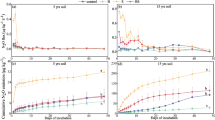Abstract
Amelioration of subsoil acidity requires an increase in Ca status along with a decrease in Al status in subsoil. In this study, effects of phosphogypsum (PG) on the amelioration of subsoil acidity have been evaluated, using cultivated and woodland subsoils representing Cecil, Wedowee (both Typic Hapludult) and Bladen (Typic Albaquult) series. Subsoil (0.6–0.8 m) samples were collected and treated with either PG (approximately 2 Mg ha-1 rate), Ca(NO3)2 or Mg(NO3)2 along with an unamended control treatment. A fertile topsoil amended with NH4NO3 was placed on top of all treated subsoil. Top and root growth of alfalfa [Medicago sativa (L.) cv. Hunter River] and soybean [Glycine max (L.) Merr. cv. Lee] were significantly greater in PG-amended than in unamended pots of the Cecil and Wedowee soils, although most growth was observed with the Ca(NO3)2-amended treatment. In the Bladen soil, however, none of the amendments evoked a significant growth response in either alfalfa or soybean. The concentration of Ca in the displaced soil solution (in soils with no plants) as well as tissue levels of Ca suggest that the growth response was partly due to an improved Ca availability in both PG or Ca(NO3)2-treated soils. Exchangeable Al decreased in PG-amended soils. The self-liming effect of PG, which is a release of OH- due to ligand exchange between SO4 2- and OH-, as well as a decrease in exchangeable Al in PG-amended soil is greater in predominantly kaolinitic Cecil and Wedowee soils than in smectitic Bladen soil. As a result, significant growth response to PG amendment was observed in the Cecil and Wedowee soils, but not in the Bladen soil.
Similar content being viewed by others
References
Adams F and Rawajfih Z 1977 Basaluminite and alunite: a possible cause of sulfate retention by acid soils. Soil Sci. Soc. Am. J. 41, 686–692.
Alva A K and Sumner M E 1989 Alleviation of aluninum toxicity to soybeans by phosphogypsum or calcium sulfate in dilute nutrient solutions. Soil Sci. 147, 278–285.
Alva A K, Sumner M E and Noble A D 1988 Alleviation of aluminum toxicity by phosphogypsum. Commun. Soil Sci. Plant Anal. 19, 383–405.
Barnhisel R and Bertsch P M 1982 Aluminum. In Methods of Soil Analysis Part 2. Eds. A L Page, R H Miller and D R Keeney. pp 275–300. Am. Soc. of Agronomy, Madison, WI.
Brown D S and Allison J D 1987 MINTEQA1, An equilibrium metal speciation model: User's Manual. Environ. Res. Lab., Office of Res. and Dev., US EPA, Athens, GA, EPA/600/3–87/012.
Buyeye S M 1986 Use of Phosphogypsum for Ameliorating Subsoil Acidity in Natal Soils M.Sc. Thesis. Univ. of Natal. Pietermaritzburg, Rep. South Africa.
Cameron R S, Ritchie G S P and Robson A D 1986 Relative toxicities of inorganic aluminum complexes to barley. Soil Sci. Soc. Am. J. 50, 1231–1236.
Coffin D E 1963 A method for the determination of free iron oxides in soils and clays. Can. J. Soil Sci. 43, 7–17.
Gillman G P 1976 A centrifuge method for obtaining soil solution. Div. Report No. 16. CSIRO, Div. of Soils, Adelaide, South Australia.
Miller W P and D MMiller 1987 A micro-pipette method for soil mechanical analysis. Commun. Soil Sci. Plant Anal. 18, 1–15.
Noble A D, Sumner M E and Alva A K 1988 Comparison of aluminon and 8-hydroxyquinoline methods in the presence of fluoride for assaying phytotoxic aluminum. Soil Sci. Soc. Am. J. 52, 1059–1063.
Pavan M A and Bingham F T 1982 Toxicity of aluminum to coffee seedlings grown in nutrient solution. Soil Sci. Soc. Am. J. 46, 993–997.
Reeve N G and Sumner M E 1972 Amelioration of subsoil acidity in Natal oxisols by leaching surface applied amendments. Agrochemophysica 4, 1–6.
Shainberg I, Sumner M E, Miller W P, Farina M P W, Pavan M A and Fey M V 1989 Use of gypsum on soils: A review. Adv. Soil Sci. 9, 1–111.
Sumner M E 1970 Aluminium toxicity — a growth limiting factor in some Natal sands. Proc. Annu. Congr. S. Afr. Sugar Technol. Assoc. 44, 1–6.
Tanaka A, Tadano T, Yamamoto K and Kanamura N 1987 Comparison of toxicity to plants among Al3+, AlSO4 +, and Al-F complex ions. Soil Sci. Plant Nutr. 33, 43–55.
Thomas G W 1982 Exchangeable cations. In Methods of Soil Analysis Part 2. Eds. A L Page, R H Miller and D R Keeney. pp 159–165. Am. Soc. of Agronomy, Madison, WI.
Author information
Authors and Affiliations
Rights and permissions
About this article
Cite this article
Alva, A.K., Sumner, M.E. Amelioration of acid soil infertility by phosphogypsum. Plant Soil 128, 127–134 (1990). https://doi.org/10.1007/BF00011101
Received:
Issue Date:
DOI: https://doi.org/10.1007/BF00011101




